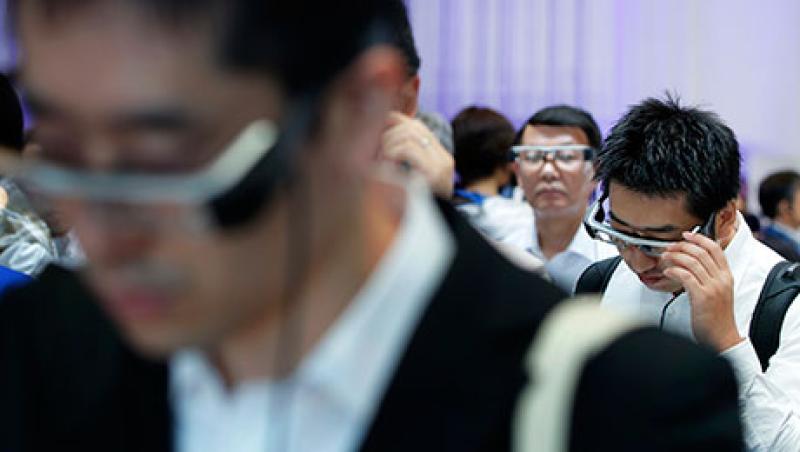For decades, the name Epson has been synonymous with printing. The Suwa, Japan–based company, formally known as Seiko Epson Corp., has sneaked its way into customers’ lives in some other ways — retail point-of-sale machines and quartz watches, for example — but many consumers don’t realize Epson’s reach into nonprinting industries. Company president Minoru Usui is hoping to change that, and change how the world works, communicates and manufactures while he’s at it.
“We are trying to change Epson’s image,” Usui said through a interpreter earlier this month. He was sitting in a low-slung chair in a small temporary room set up in an art gallery in Manhattan’s Chelsea neighborhood that Epson had taken over for the day to showcase some of its newest products. Attractions included a demonstration of the company’s projection mapping technology, which casts interactive images onto 3-D surfaces; a presentation of how Epson uses robots to operate a machine that prints on fabric, creating designs for New York Fashion Week; and a pair of Epson’s Moverio smart glasses, which are marketed to businesses for use in tasks such as remote repairs.
Usui’s plan for Epson, which includes the eventual widespread use of Epson-made robots on assembly lines, is an ambitious one that comes as the company seeks to reinvent itself after years of turbulence on its balance sheet. Since Usui became president in 2008, he has taken several calculated risks toward expanding a business that depends on consumers’ use of paper in an increasingly paperless world. The first risk was refocusing Epson’s energies on ink-jet printing, and so far that has appeared to pay off. As of May, after nearly a decade of ups and downs, the company had completed two consecutive years of record profits, totaling ¥111 billion ($916 million), and revenue for the quarter ended June 30 grew 6 percent over the previous quarter. This improved performance is thanks in part to the EcoTank printer series, a range of ink-jet models for home and office use that aim to get around consumers’ biggest gripe: the expense and hassle of replacing ink cartridges. With EcoTank, which has done well for months in Europe and Japan and was announced last month in the U.S., getting started is more expensive — the cheapest consumer model costs about $380 — but ink lasts about two years, or about 4,000 pages in black and white and 6,500 pages in color. The printers will be available in stores by the end of September.
“Within two to five years, we think these printers will represent 25 percent of the ink-jet printer market,” says Epson America CEO John Lang. “It will take a while to educate people, because they’re not used to the price point, but it will be useful for home offices and small businesses.”
This longer-lasting ink strategy is in direct response to customer complaints, as well as to the growth of competing laser printer businesses. It was made possible in part by Epson’s ceramic print head, which uses pressure to push out ink instead of boiling it, as competitors do. This allows for more economical use of ink and also makes it possible to print with materials other than ink.
But the company’s real proprietary asset, and the thing it is counting on for the success of its newer products, is the sensor. Seiko Epson, founded in 1942, built the first quartz watch in 1969. That crystal technology ended up being the basis for the print head and sensor technology that made Epson an office- and household name long after Americans had been wearing watches made possible by the company. It’s also the technology that has grown wearables and industrial products, including robotics, to about 16 percent of consolidated revenue for the fiscal year ended March 31.
Epson has had these capabilities for some time, but is now pursuing them with more urgency, says Usui. “We own the core technology in all the products, so we can refine and make them better and better over time,” he explains. “Many companies, including our major competitors in printing, don’t own their own factories. We aim to create things that don’t exist, so we control the whole process and create a virtuous circle.”
But not everyone is convinced by the flashy new products or business plan. Tetsuya Wadaki, an analyst with Tokyo-based Nomura Holdings who covers Epson, notes that the introduction of these new businesses comes after several years of restructuring and the elimination of less profitable parts of the company.
“We assume the objective of some of these product developments was maintaining the motivation of the engineers,” Wadaki wrote in an e-mail. “Therefore, we suppose wearables, 3-D projection, textiles and robotics won’t have a significant impact on the performance of Seiko Epson in the future.”
Wadaki says he also doesn’t believe that the fanfare around the new businesses will have much impact on the company’s stock price. Epson’s stock, which trades on the Tokyo Stock Exchange, has lost about 15 percent year-to-date, closing Monday at ¥2,129 ($17.11) per share.
Epson may have something even bigger in store, however. Usui and Lang say the company is researching ways to incorporate 3-D printing into its business, and not in the consumer-facing way many other companies have approached the technology. Instead of selling in-home 3-D printers, a business that has lagged after an initial flurry of excitement several years ago, Epson plans to use 3-D printing on its production lines. First, the company has to iron out issues of durability, precision and speed.
“Epson is planning to conquer all of these [issues] and have a world-beating 3-D printer,” says Usui.
Once this technology is perfected, Usui believes Epson will help usher in “a new Industrial Revolution,” staffing production lines with robots assembling 3-D-printed parts, leaving workers free to dream up the next big thing.
Follow Kaitlin Ugolik on Twitter at @kaitlinugolik.





